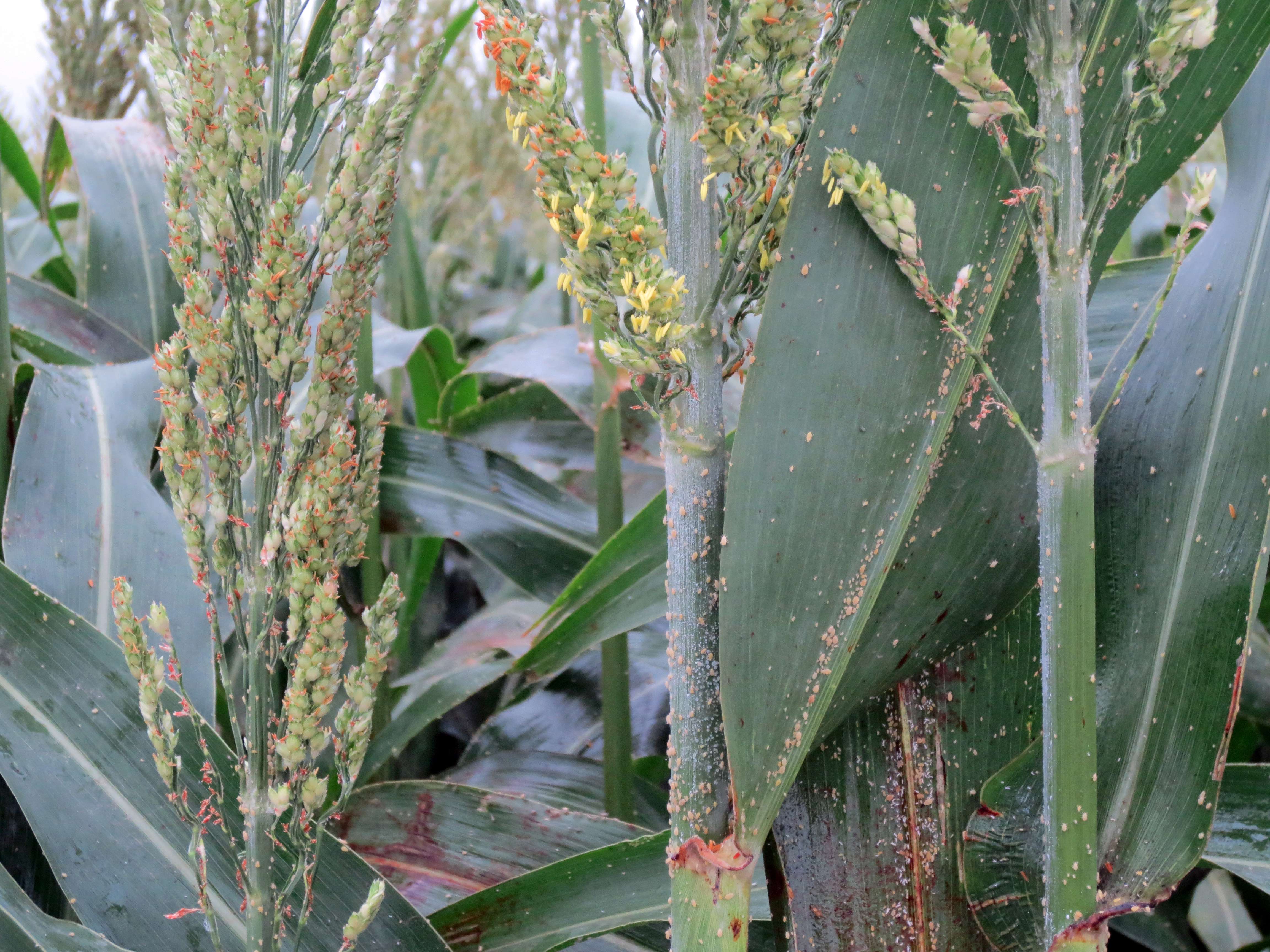Welasco, Texas, USA
May 14, 2014
Texas A&M AgriLife Extension Service scientists are warning South Texas grain sorghum producers to be on the lookout for a new insect pest that, left unchecked, could wipe out their entire crop.

A heavy infestation of sugarcane aphids is shown migrating from the grain sorghum stalk to the head. (AgriLife Extension photo by Danielle Sekula-Ortiz)
Dr. Raul Villanueva, an AgriLife Extension entomologist, and Danielle Sekula-Ortiz, an AgriLife Extension integrated pest management agent, say that in recent weeks they have documented explosive populations of sugarcane aphids at levels never seen here before.
To more fully explain to growers the situation, biology and treatment of the sugarcane aphid, the “Sugarcane Aphid Informative Meeting and Field Day” will be held from 9-10 a.m. May 20 at the Texas A&M AgriLife Research and Extension Center at Weslaco, located at 1015 E. U.S. Highway 83.
“We saw damaging populations of the sugarcane aphid in grain sorghum late in the season last year, but we didn’t see any major problems in the head, where the grain is produced,” Villanueva said. “So, we were hoping it was a one-time event or only a late-season event, or that it wouldn’t affect the head.
“But it’s now obvious that is not the case. We started seeing very high populations three weeks ago, about the time plants were putting out their grain heads.”
Worse still, it became obvious that without treatment, the insects migrate from lower leaves to the head, the “cash crop” area of the plant, Sekula-Ortiz said.
“Why populations increase so dramatically at this stage is not known,” she said. “It could be environmental, in that they prefer higher temperatures, or that the aphids prefer mature plants, or that the seed treatment, which is designed to protect the plant from aphids in the plants’ early stages, simply wears off. Or it could be a combination of those factors.”
Regardless, if growers don’t treat before they migrate to the head, serious crop losses can occur, she said.
“These aphid infestations are hard to spot at first because a field can look nice and green,” Sekula-Ortiz said. “Aphids hide on the underside of the leaves. It’s not until infestations are high that leaf damage becomes visible. Aphids on higher leaves drop their waste, called honeydew, onto the tops of leaves below. First they glisten from the honeydew, then they turn brown as the honeydew attracts sooty mold.”
Once aphids migrate to the head of the sorghum plant, yields are reduced because grains don’t mature, they fail to grow to normal size or numbers, Villanueva said.
“The aphids consume the plants’ cholorphyll and interfere with the plants’ photosynthesis,” he said. “So it’s very important that growers spray a recently approved insecticide before the aphids move up into the head, or panicle.”
The U.S. Environmental Protection Agency recently approved the Texas Department of Agriculture’s request for emergency use of a product called Transform on grain sorghum to treat for sugarcane aphids.
“The permit was issued April 24 and expires Oct. 31,” Sekula-Ortiz said. “Hopefully, that will help avoid serious crop losses in the current crop of about 250,000 acres, which was planted in mid-February and will be harvested in late June or early July.”
Because of its subtropical climate, Lower Rio Grande Valley growers typically plant a second, much smaller crop of about 50,000 acres in August, which they typically harvest in December.
The sugarcane aphid is not to be confused with another aphid on grain sorghum that growers are much more familiar with, the yellow sugarcane aphid, Villanueva said. The yellow sugarcane aphid affects the lower leaves of plants. Because it is present only during a plant’s early stages, its populations are kept in check by seed treatment and do not pose a problem.
“The sugarcane aphid, by nature, is a much more serious threat,” he said. “As are most aphid species, it is parthenogenetic, meaning populations are all female and don’t require a male to reproduce. When populations become overcrowded, some develop wings and fly off to other fields or plants to colonize there. As soon as they land they don’t lay eggs, they simply give birth to new female aphids. That’s one reason why populations can quickly spread and reach critical levels.”
Aside from the Rio Grande Valley, the sugarcane aphid has also been reported this year in Mexico, Corpus Christi and Beaumont. Both Villanueva and Sekula-Ortiz believe populations will continue moving north as they did last year when they migrated as far as Oklahoma.
“However, so far, there are no reports of any sugarcane aphids west of IH-35 or in the Texas Panhandle,” Villanueva said.